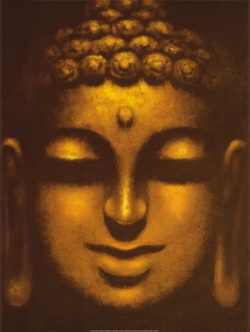Other Chinese Pure Land Masters
A Chinese monk of the Eastern Chin dynasty. After studying under the Buddhist scholar Tao-an, he went to Mt. Lu where he founded a religious group based on nembutsu practice, known as the White Lotus Society. This community marks the advent of Pure Land Buddhism in China. Rather than the recited nembutsu, Hui-yuan's practice was based on visualization of Amida and attaining states of samadhi as taught in the Pratyutpanna Sutra (Jp. Hanju-zammai-kyo). This teaching succeeded onwards to the T'ien-t'ai founder Chih-i (538-97) and the Hua-yen master Ch'eng-kuan (738-839).
Chia-ts'ai (Jp. Kazai) [circa 7th century] Chia-ts'ai wrote the Ch'ing-tu-lun (Treatise on the Pure Land), the first notable work in the "Legends of Births" genre (Ch. wang-sheng-chuan, Jp. ojoden). These "Legends of Births" are accounts of various people, not just monks, who gained Birth in the Pure Land. The Ching-t'u-lun includes accounts, one specifically by Tao-cho, recommending the recited nembutsu. As such, this work coincides with the rise of nembutsu recitation in China as a means for Birth. This genre of writings had a great impact on the Japanese Pure Land tradition and attained a very high form in Japan. (Lai, 173-232)
T'zu-min (Jp. Jimin) [680-748]
T'zu-min is the founder of the T'zu-min school of Chinese Pure Land teachings and is significant for helping to develop the common trend in Chinese Buddhism of combining Ch'an (Jp. Zen) meditation, Pure Land nembutsu practice, and the strict observation of of the monastic precepts (vinaya). This syncretic style of practice contrasts the typical feature of Japanese Pure Land Buddhism of exclusive nembutsu practice (senju-nembutsu) developed by Honen.
Fa-chao (Jp. Hossho) [756-822]
The originator of the "fivefold Nembutsu" involving the intonation of Amida Buddha's name five times in the five tones of the Chinese musical scale (wu-hui-nien-fo). He was greatly influenced by Shan-tao and was considered by some to be a reincarnation of him.
Notes:
1. T'ang kao-seng-chuan, T. 2060, 50:593c & Hsin-shu wang-sheng-chuan, JZ. second series, 16:90b.
References:
Lai, Whalen "Legends of Births and the Pure Land Tradition in China" in The Pure Land Tradition: History and Development, Eds. James Foard, Michael Solomon, Richard Payne (Berkeley, CA: Regents of the University of California & Institute of Buddhist Studies, 1996).
Pictures of Jodogoso from Shojoke-in, Kyoto
